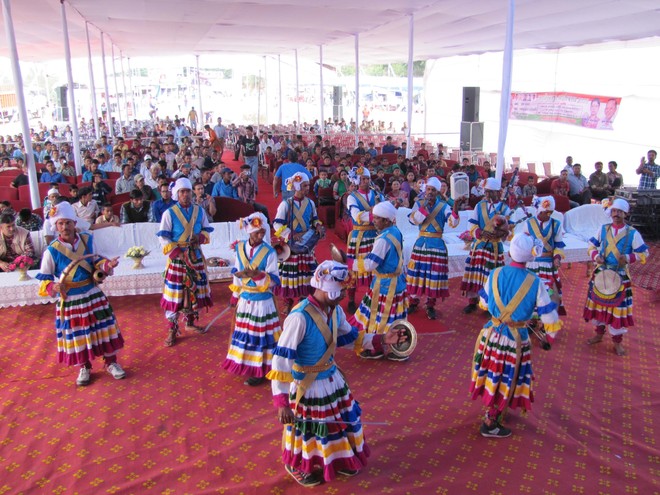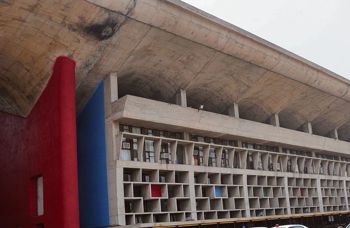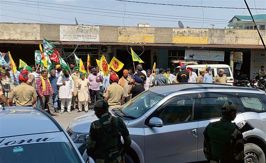
Local people wearing Ghagra, Angra and Pichaura headgear perform at a function in Pithoragarh. A Tribune photo
BD Kasniyal
Pithoragarh, July 12
As an ancient society, Kumaon is known for inclination towards clothes, though the attires of poor rural folks and those of feudal were different. Besides clothes of silk and cotton, local people in the ancient to medieval times used Hemp (Bhang or Som plant of the Vedic period), Bhimal and Malu plants to make cheap clothes for themselves. “The turning point in attires came in society when clothes from mills started arriving in Kumaon marts and markets after the First World War,” says PD Pant, an expert on the Kumaon culture.
According to first English land settlement officer Charles Batten (1841), several villages of Ashi Chalsi Patti in the Kali Kumaon region (at present in Champawat district) grew Hemp plants in large numbers. The fibre extracted from the stem of the plant was used to knit clothes for villagers. The clothes were knit by the Koli community of the Kumaon region. Rahul Sankrityayan has written in his book "Vedic Bharat" that the Hemp fibre clothes were available for sale in the Uttarayani fair of Bageshwar. “The tradition of making clothes from Hemp fiber was prevalent not only in north India but also in China, middle Asia and European countries,” writes Rahul in his book.
Koli community of Almora wove fabrics
Batten also mentions about the cultivation of Hemp in the Salam belt of Almora and cotton farming in Bora Row and Kaira Row villages in Almora and the Sor valley of Pithoragarh for the purpose of making clothes. “People from each village and every household in the Kumaon region used to grow cotton, process it and make thread by spinning the fibre in homemade wheels. Thereafter, the thread was given to members of the Koli community, who used to make clothes of it,” says Pant.
According to some experts, common Kumauni villagers had the same exposure to cotton and woollen clothes in the middle ages. While cotton was spun in almost every village, they took woollen clothes for the winter from Bhotia tribal businessmen in exchange of goods. During the winter, Kumauni people used to wear woollen Mirjai which they made themselves from wool obtained from traders in exchange of cereals. These traders used to bring wool from Tibet. “Even the oldest Hindu social lawmaker Manu has mentioned Nepalese woollen blankets that were used in the Kumaon region by the people of his time,” says Pant.
Woollen Laba was women's favourite
Another cultural historian Dr Chandra Singh Chauhan, who is the in charge of the Almora museum, says the common Kumauni in the middle ages used to wear Laba, a woollen cloth that covered the body from head to feet. Laba was made tight by putting an iron weight at its lower rings. “While men used to wear a black cotton Laba, Langot (small dhoti) and Mirjai, women used to wear Dhoti, Ghagra and Angra (skirt like cloth) covered by a Pichora or a shawl. The women’s dress used to be complete when they wore a safa or pagri on their heads,” he says. “The dress later changed and people started wearing Churidar pyjama (wringed trouser) kurta, round cap, Jawar cap and Mirjai and dhoti after the British arrived in Kumaon," says Pant.
Time tested
- Chung,a short-sleeved coat that reaches down to anklets
- Phu, a skirt that was fastened around the waist
- Jujang, a long sheet used with Phu
- Laba, a woollen cloth that covered the body from head to feet
- Langot, a small dhoti, Mirjai & Ghagra
- Angra (skirt like cloth) covered by Pichora
- Rangwali Pichora, a 3x1.25 metre long cotton cloth coloured in dark red on sharp yellow background
- Local people in the ancient to medieval times wore clothes made of Hemp (Bhang or Som plant of the Vedic period), Bhimal and Malu plants
- Koli community was engaged in making clothes
Bhotias wore homemade coats, shirts, and skirts
According to experts from the tribal community residing in Dharchula and Munsiyari subdivisions of Pithoragarh district, tribal people living in Johar, Byans, Darma and Chaundas valleys of the region had a rich sense of dressing throughout the middle and ancient ages. As they were traders, they became aware of cotton, silk and other rich woollen fibres the 9th century onwards when they started trading with Tibet. “While western Bhotia men of the Johar valley used to wear homemade coats, and trousers with caps of woollen stuff, their women used to wear skirt coats, shirts and waistcoats with long head gears. The ancient dress of eastern Bhotia women of Darma, Byans and Chaundas valleys was short-sleeved coats called Chung, which reached down to anklets, and a skirt called Phu that was fastened around the waist by a long sheet called Jujang. But their dress was said to be complete when they wore a cap called V Chungti and long woollen boots,” says Sher Singh Pangti, a tribal historian and manager of the museum on tribal craft at Munsiyari.
Rangwali Pichora for special occasions
On auspicious occasions, especially during marriage and religious festivities, Kumauni women commonly wore Rangwali Pichora, a 3x1.25 metre long cotton cloth coloured in dark red on sharp yellow background. “Even coloured and dyed clothes were made at home by using several herbs available locally,” says Navin Singh Bisht, a journalist based in Almora.
The dressing sense and preferences of Kumauni people gradually changed and they started wearing dhoti, later on pyjama and now trousers and Mirjai without buttons that covered the body up to knee. “These middle or ancient era dresses were replaced by short pants for men and sari petticoat and blouse for women while children used to wear a dress called Jhagula in the local dialect after the British arrived in the Kumaon region in 1815,” says Pant.



























